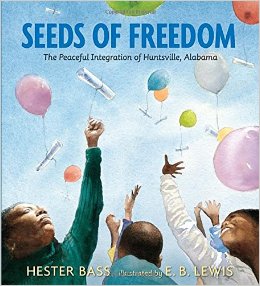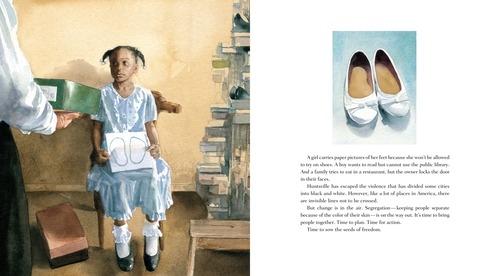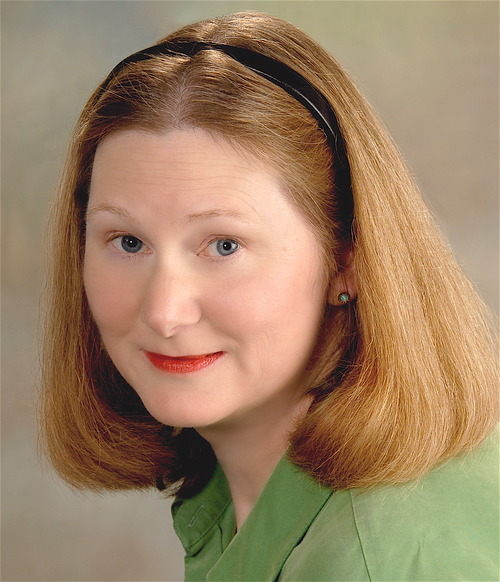Possessed by an Idea, Embraced by the Other

Contributed to CBC Diversity by Hester Bass
When I visit schools, it’s the question I am asked most often: where do you get your ideas? I jokingly answer “on sale at Target” before revealing the truth: ideas come from everywhere all the time.
The idea for my book, Seeds of Freedom: The Peaceful Integration of Huntsville, Alabama (Candlewick Press, illustrated by E.B. Lewis) came from two historical markers I noticed in that city where I lived for ten years, noting that the first instance of both an integrated public school and a “reverse-integrated” private school occurred there during the same week in September 1963. I went straight to the public library, expecting to find a children’s book about these events, but none existed. It seemed the idea had chosen me.
I became committed to celebrating this peaceful chapter in civil rights history, spending six years researching in the library’s historical collections and interviewing local people. I was also transported to my own experiences as a first grader in 1962.
My memories of the Civil Rights Movement are those of a child in rural Georgia, mostly from a black-and-white television set. I remember it seemed strange that there was so much upset over the color of skin, something no one can choose or change.
I was taught by my parents and grandparents that every person deserves respect, and that differences are what make people interesting. At my elementary school – the only one in town, as far as I knew – all my classmates were white like me. When I saw black children at the five-and-dime and wondered about it, my mother explained they had a separate school, but I couldn’t understand why it was needed. Integration came late to my school, when I was in fifth grade, but peacefully, without any incident that I can recall.

When I wrote the book, I assumed I’d live in Huntsville when it was published; however, two years ago, my family moved to Santa Fe, New Mexico – a crossroads of Native, Hispanic, and Anglo culture for hundreds of years.
During visits to some of the nineteen pueblos in the state, I’ve been appalled to learn about atrocities committed against native peoples by the Spanish and by Americans. I asked one Native American tour guide how he could relate such devastating past events to audiences – whose ethnicity was similar to those who had been so cruel to his people – without any trace of bitterness. He smiled and replied calmly: you and I did not do these terrible things, he said, and a grudge only harms the person who holds it. When I expressed my sorrow and regret anyway, he smiled again and said that apology is not required, only learning from the past to create a better future.
This tour guide’s choice to reject ethnic hatred reminded me of why I had been so determined to publish this story. I had heard the same lack of resentment in the voice of Dr. Sonnie W. Hereford III, as he related the events of January 1962 to September 1963 that are the basis for the book.
Dr. Hereford had been denied basic human rights in his hometown and, as a professional man, could have relocated his family to a less segregated city. But Dr. Hereford and his wife chose to remain and lead peaceful protests in order to make a positive difference for their children and everybody else, as did others who could have left town without taking such risks.
The responses of these two men – a Native American tour guide in New Mexico and an African-American medical doctor in Alabama – whose experiences were so different from mine, made me feel embraced by the “other,” even more resolved to celebrate this true story, when the black and white people of Huntsville chose peace over violence.
The civil rights era is but one of the many episodes of differences between groups of people that have led to violent times in America. The message I hope Seeds of Freedom carries forward is that, while problems accepting diversity in the world persist, solving them through peaceful means is not only preferable but possible. Each of us is faced with choices every day, and we can all choose peace.


Hester Bass is the author of the picture book biography The Secret World of Walter Anderson, illustrated by E.B. Lewis, which won an Orbis Pictus Award for Outstanding Nonfiction for Children, as well as the picture book So Many Houses, illustrated by Alik Arzoumanian. Formerly residing in Huntsville, Alabama, she now lives in Santa Fe, New Mexico.

